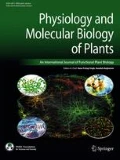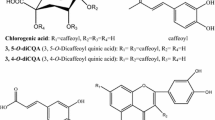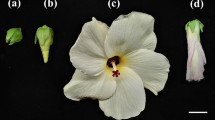Abstract
Our previous study showed that flowers of Agastache rugosa had higher phenolic levels and higher antibacterial and antioxidant capacity compared to those of the leaves and stems. The aim of this study was to provide information on the variation in primary and secondary metabolites during flower development in A. rugosa by using high performance liquid chromatography (HPLC) and assays of total anthocyanin (TAC), flavonoid (TFC), and phenolic content (TPC), as well as gas chromatography time-of-flight mass spectrometry (GC-TOFMS) analysis. Assays of TPC, TAC, and TFC showed that the floral bud (stage I) contained higher TPC than did the partially open flower (stage II) and fully open flower (stage III). However, the TFC was the highest at stage II, and the highest TAC was observed at stage III. Furthermore, HPLC analysis revealed that the level of total phenylpropanoids, including rosmarinic acid, tilianin, acacetin, 4-hydroxybenzoic acid, caffeic acid, chlorogenic acid, trans-cinnamic acid, rutin, (-)-epicatechin, quercetin, and kaempferol, was higher in stages I and II, but the concentrations of rutin and rosmarinic acid were highest in stage III. A total of 43 compounds, including amino acids, organic acids, phenolic compounds, sugars, photorespiration-related compounds, and intermediates of the tricarboxylic acid cycle, were identified through GC-TOFMS analysis. Of these compounds, most amino acids decreased during flower development. In contrast, the increase in concentrations of glucose and sucrose were observed from stages I to III. In this study, health-beneficial compounds were identified and quantified in flowers of A. rugosa. Accordingly, our results suggests that A. rugosa flowers can potentially be used as biomaterials for pharmaceuticals, cosmetics, food, and related industries.






Similar content being viewed by others
References
An JH, Yuk HJ, Kim DY, Nho CW, Lee D, Ryu HW, Oh SR (2018) Evaluation of phytochemicals in Agastache rugosa (Fisch. & C.A.Mey.) Kuntze at different growth stages by UPLC-QTof-MS. Ind Crops Prod 112:608–616
Bily AC, Burt AJ, Ramputh AL, Livesey J, Regnault-Roger C, Philogene BR, Arnason JT (2004) HPLC-PAD-APCI/MS assay of phenylpropanoids in cereals. Phytochem Anal 15(1):9–15
Borghi M, Fernie AR (2017) Floral metabolism of sugars and amino acids: Implications for pollinators’ preferences and seed and fruit set. Plant Physiol 175(4):1510–1524
Clarke CJ, Haselden JN (2008) Metabolic profiling as a tool for understanding mechanisms of toxicity. Toxicol Pathol 36(1):140–147
Diaz AM, Abad MJ, Fernandez L, Silvan AM, De Santos J, Bermejo P (2004) Phenylpropanoid glycosides from Scrophularia scorodonia: In vitro anti-inflammatory activity. Life Sci 74(20):2515–2526
Douglas CJ (1996) Phenylpropanoid metabolism and lignin biosynthesis: from weeds to trees. Trends Plant Sci 1(6):171–178
Duenas M, Gonzalez-Manzano S, Gonzalez-Paramas A, Santos-Buelga C (2010) Antioxidant evaluation of O-methylated metabolites of catechin, epicatechin and quercetin. J Pharmaceut Biomed 51(2):443–449
Estrada-Reyes R, Hernández EA, García-Argáez A, Hernández MS, Linares E, Bye R, Heinze G, Martínez-Vázquez M (2004) Comparative chemical composition of Agastache mexicana subsp: mexicana and A. Mexicana subsp xolocotziana Biochem Syst Ecol 32:685–694
Ferri M, Righetti L, Tassoni A (2011) Increasing sucrose concentrations promote phenylpropanoid biosynthesis in grapevine cell cultures. J Plant Physiol 168(3):189–195
Higdon JV, Delage B, Williams DE, Dashwood RH (2007) Cruciferous vegetables and human cancer risk: epidemiologic evidence and mechanistic basis. Pharmacol Res 55(3):224–236
Janicsak G, Mathe I, Mikklosy-Vari V, Blunden G (1999) Comparative studies of the rosmarinic and caffeic acid contents of Lamiaceae species. Biochem Syst Ecol 27:733–738
Kahkonen MP, Heinonen M (2003) Antioxidant activity of anthocyanins and their aglycons. J Agr Food Chem 51(3):628–633
Kang Y-H, Park Y-K, Lee G-D (1996) The nitrite scavenging and electron donating ability of phenolic compounds. Korean J Food Sci Technol 28:232–239
Kim DO, Jeong SW, Lee CY (2003) Antioxidant capacity of phenolic phytochemicals from various cultivars of plums. Food Chem 81(3):321–326
Lee J, Finn CE (2012) Lingonberry (Vaccinium vitis-idaea L.) grown in the Pacific Northwest of North America: Anthocyanin and free amino acid composition. J Funct Foods 4(1):213–218
Lee CH, Kim HN, Kho YE (2002) Agastinol and agastenol: novel lignans from Agastache rugosa and their evaluation in an apoptosis inhibition assay. J Nat Prod 65:414–416
Lee TH, Park SJ, Yoo GJ, Jang CY, Kim MH, Kim SH, Kim SY (2016) Demethyleugenol β-glucopyranoside isolated from Agastache rugose decreases melanin synthesis via down-regulation of MITF and SOX9. J Agric Food Chem 64:7733–7742
Lim SS, Jang JM, Park WT, Park SU (2013) Chemical composition of essential oils from flower and leaf of Korean mint, Agastache rugosa. Asian J Chem 25:4361–4363
Lloyd JC, Zakhleniuk OV (2004) Responses of primary and secondary metabolism to sugar accumulation revealed by microarray expression analysis of the Arabidopsis mutant, pho3. J Exp Bot 55(400):1221–1230
Morel I, Lescoat G, Cogrel P, Sergent O, Pasdeloup N, Brissot P, Cillard P, Cillard J (1993) Antioxidant and iron-chelating activities of the flavonoids catechin, quercetin and diosmetin on iron-loaded rat hepatocyte cultures. Biochem Pharmacol 45(1):13–19
Natella F, Nardini M, Di Felice M, Scaccini C (1999) Benzoic and cinnamic acid derivatives as antioxidants: Structure-activity relation. J Agr Food Chem 47(4):1453–1459
Park CH, Baskar TB, Park SY, Kim SJ, Arasu MV, Al-Dhabi NA, Kim JK, Park SU (2016a) Metabolic profiling and antioxidant assay of metabolites from three radish cultivars (Raphanus sativus). Molecules 21(2):157
Park CH, Kim YS, Li X, Kim HH, Arasu MV, Al-Dhabi NA, Lee SY, Park SU (2016b) Influence of different carbohydrates on flavonoid accumulation in hairy root cultures of Scutellaria baicalensis. Nat Prod Commun 11(6):799–802
Park WT, Arasu MV, Al-Dhabi NA, Yeo SK, Jeon J, Park JS, Lee SY, Park SU (2016c) Yeast extract and silver nitrate induce the expression of phenylpropanoid biosynthetic genes and induce the accumulation of rosmarinic acid in Agastache rugosa cell culture. Molecules 21(4):426
Park CH, Yeo HJ, Kim NS, Eun PY, Kim SJ, Arasu MV, Al-Dhabi NA, Park SY, Kim JK, Park SU (2017) Metabolic profiling of pale green and purple kohlrabi (Brassica oleracea var. gongylodes). Appl Biol Chem 60(3):249–257
Park CH, Park SY, Lee SY, Kim JK, Park SU (2018) Analysis of metabolites in white flowers of Magnolia denudata Desr. and violet flowers of Magnolia liliiflora Desr. Molecules 23(7):1558
Park CH, Yeo HJ, Baskar TB, Park YE, Park JS, Lee SY, Park SU (2019) In vitro antioxidant and antimicrobial properties of flower, leaf, and stem extracts of Korean mint. Antioxidants-Basel 8(3):75
Park CH, Park SY, Park YJ, Kim JK, Park SU (2020a) Metabolite Profiling and Comparative Analysis of Secondary Metabolites in Chinese Cabbage, Radish, and Hybrid xBrassicoraphanus. J Agric Food Chem 68(47):13711–13719
Park WT, Yeo SK, Sathasivam R, Park JS, Kim JK, Park SU (2020b) Influence of light-emitting diodes on phenylpropanoid biosynthetic gene expression and phenylpropanoid accumulation in Agastache rugosa. Appl Biol Chem 63:25
Park CH, Park YE, Yeo HJ, Yoon JS, Park SY, Kim JK, Park SU (2021a) Comparative Analysis of Secondary Metabolites and Metabolic Profiling between Diploid and Tetraploid Morus alba L. J Agric Food Chem 69(4):1300–1307
Park CH, Xu H, Yeo HJ, Park YE, Hwang GS, Park NI, Park SU (2021b) Enhancement of the flavone contents of Scutellaria baicalensis hairy roots via metabolic engineering using maize Lc and Arabidopsis PAP1 transcription factors. Metab Eng 64:64–73
Payyavula RS, Singh RK, Navarre DA (2013) Transcription factors, sucrose, and sucrose metabolic genes interact to regulate potato phenylpropanoid metabolism. J Exp Bot 64(16):5115–5131
Schmitzer V, Veberic R, Osterc G, Stampar F (2009) Changes in the phenolic concentration during flower development of rose “KORcrisett.” J Am Soc Hortic Sci 134(5):491–496
Schmitzer V, Veberic R, Osterc G, Stampar F (2010) Color and phenolic content changes during flower development in groundcover rose. J Am Soc Hortic Sci 135(3):195–202
Sharma A, Thakur S, Kumar V, Kanwar MK, Kesavan AK, Thukral AK, Bhardwaj R, Alam P (2016) Ahmad P (2016) Pre-sowing seed treatment with 24-Epibrassinolide ameliorates pesticide stress in Brassica juncea L. through the modulation of stress markers. Front. Plant Sci. 7:1569
Sharma A, Yuan H, Kumar V, Ramakrishnan M, Kohli SK, Kaur R, Thukral AK, Bhardwaj R, Zheng B (2019) Castasterone attenuates insecticide induced phytotoxicity in mustard. Ecotoxicol Environ Saf 179:50–61
Sutharut J, Sudarat J (2012) Total anthocyanin content and antioxidant activity of germinated colored rice. Int Food Res J 19:215–221
Torel J, Cillard J, Cillard P (1986) Antioxidant activity of flavonoids and reactivity with peroxy radical. Phytochemistry 25:383–385
Tuan PA, Park WT, Xu H, Park NI, Park SU (2012) Accumulation of tilianin and rosmarinic acid and expression of phenylpropanoid biosynthetic genes in Agastache rugosa. J Agr Food Chem 60(23):5945–5951
Vaidyanathan S, Goodacre R (2003) Metabolome and proteome profiling for microbial characterization. In: Harrigan GG, Goodacre R (eds) Metabolic profiling: its role in biomarker discovery and gene function analysis. Springer, Boston, US, MA, pp 27–28
Yeo HJ, Park CH, Lee KB, Kim JK, Park JS, Lee JW, Park SU (2018) Metabolic analysis of Vigna unguiculata sprouts exposed to different light-emitting diodes. Nat Prod Commun 13(10):1349–1354
Yu N, Wei S, Li M, Yang J, Li K, Jin L, Xie Y, Giesy JP, Zhang X, Yu H (2016) Effects of perfluorooctanoic acid on metabolic profiles in brain and liver of mouse revealed by a high-throughput targeted metabolomics approach. Sci Rep 6:1–10
Zielińska S, Matkowski A (2014) Phytochemistry and bioactivity of aromatic and medicinal plants from the genus Agastache (Lamiaceae). Phytochem Rev 13:391–416
Acknowledgements
This study was supported by a grant from Basic Science Research Program through the National Research Foundation of Korea (NRF) funded by the Ministry of Education, Science and Technology (20110010231).
Author information
Authors and Affiliations
Contributions
S.Y.L. and S.U.P. designed and carried out the experimental part of the manuscript. H.J.Y., C.H.P., Y.E.P., H.H., and J.K.K. performed the experiments and wrote the paper. H.J.Y., C.H.P., and Y.E.P. were involved in analyzing and monitoring the data and experiment. H.J.Y. and C.H.P. wrote the manuscript. All of the authors read and approved the final manuscript.
Corresponding author
Ethics declarations
Conflict of interest
The authors declare no competing interests, including financial and non-financial interests.
Additional information
Publisher's Note
Springer Nature remains neutral with regard to jurisdictional claims in published maps and institutional affiliations.
Supplementary information
Rights and permissions
About this article
Cite this article
Yeo, H.J., Park, C.H., Park, Y.E. et al. Metabolic profiling and antioxidant activity during flower development in Agastache rugosa. Physiol Mol Biol Plants 27, 445–455 (2021). https://doi.org/10.1007/s12298-021-00945-z
Received:
Revised:
Accepted:
Published:
Issue Date:
DOI: https://doi.org/10.1007/s12298-021-00945-z




